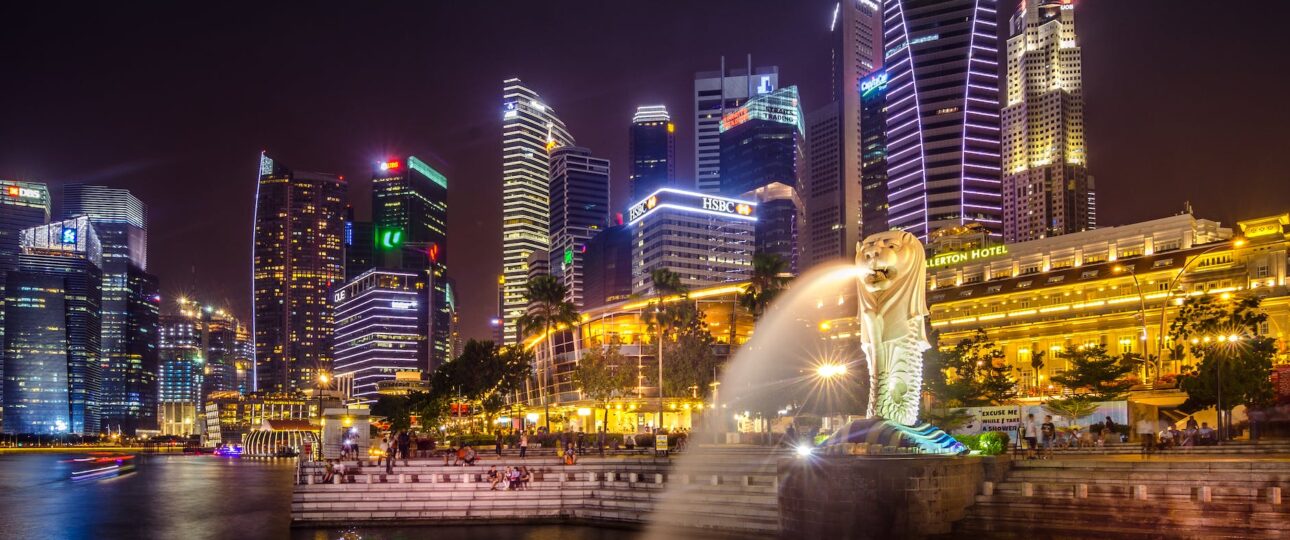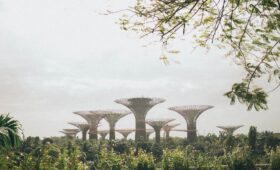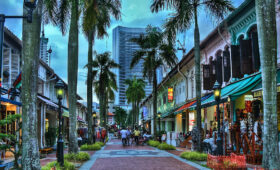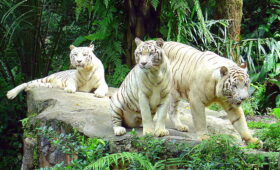The Merlion, a mythical creature with the head of a lion and the body of a fish, holds a special place in the hearts of Singaporeans and represents the city-state’s prosperity and resilience. This iconic symbol is deeply rooted in Singapore’s history and has become synonymous with the nation’s progress and success.
Key Takeaways:
- The Merlion is a mythical creature with the head of a lion and the body of a fish.
- It is regarded as a symbol of prosperity and resilience in Singapore.
- The most famous depiction of the Merlion is a statue located at Merlion Park near the Central Business District.
- The statue stands at 8.6 meters tall and weighs 70 tonnes.
- There are also other authorized Merlion statues in Singapore, including one on Sentosa Island.
The History and Origins of the Merlion
The history of the Merlion can be traced back to the origins of Singapore as a small fishing village, where the creature became a symbol of the city-state’s remarkable transformation into a thriving metropolis. This mythical creature, with the head of a lion and the body of a fish, represents the fusion of Singapore’s humble beginnings and its aspirations for prosperity.
According to local folklore, the name “Merlion” is a combination of “mer,” which means sea in Old English, and “lion,” representing the city-state’s “lion city” moniker. The concept of the Merlion symbol emerged in the 1960s as a marketing initiative to promote Singapore’s tourism industry.
The most famous depiction of the Merlion is the majestic statue located at Merlion Park near the Central Business District. Crafted by local artisan Lim Nang Seng, the statue stands tall at 8.6 meters and weighs a staggering 70 tonnes. Unveiled in 1972, the Merlion statue faces east, symbolizing the belief that prosperity will flow into Singapore from the sea.
| Key Facts: | |
|---|---|
| Height: | 8.6 meters |
| Weight: | 70 tonnes |
| Location: | Merlion Park, near the Central Business District |
The Merlion’s significance goes beyond its physical presence at Merlion Park. It embodies Singapore’s lion-hearted spirit and resilience as it has withstood the test of time and become an iconic symbol of the city-state’s progress and prosperity. The popularity of the Merlion has led to the creation of other authorized Merlion statues in Singapore, including one on Sentosa Island, further cementing its status as a beloved national symbol.
The Iconic Merlion Statue at Merlion Park
The most famous depiction of the Merlion can be found at Merlion Park, near Singapore’s Central Business District, where an impressive statue stands tall, captivating visitors from around the world. This iconic symbol of Singapore, with the head of a lion and the body of a fish, represents the city-state’s origins as a humble fishing village and its lion-hearted spirit.
Standing at a majestic height of 8.6 meters and weighing 70 tonnes, this awe-inspiring Merlion statue was created by local craftsman Lim Nang Seng and unveiled in 1972. Positioned to face east, a direction believed to bring prosperity, the statue holds deep symbolic importance for Singaporeans and tourists alike.
Merlion Park offers a breathtaking view of the Marina Bay Sands and the Singapore skyline, making it a popular spot for visitors to capture memorable photographs. The park also features a smaller Merlion statue, standing at 2 meters tall and weighing 3 tonnes, which adds to the charm of this picturesque waterfront location.
Table: Facts about the Merlion Statue at Merlion Park
| Height | Weight | Creator | Unveiled |
|---|---|---|---|
| 8.6 meters | 70 tonnes | Lim Nang Seng | 1972 |
Beyond its visual appeal, the Merlion statue at Merlion Park holds deep cultural and historical significance. It serves as a reminder of Singapore’s fascinating journey from a small fishing village to a thriving metropolis, representing the city’s resilience and determination to overcome challenges.
The Symbolic Importance of the Merlion
Beyond its mythical charm, the Merlion holds a deep symbolic meaning for Singapore, representing the city-state’s origins as a fishing village and its resilient and lion-hearted spirit. The Merlion, with the head of a lion and the body of a fish, encapsulates the unique blend of strength and adaptability that has defined Singapore throughout its history.
The most famous representation of the Merlion is the majestic statue located at Merlion Park near the Central Business District. Standing at an impressive height of 8.6 meters and weighing 70 tonnes, this iconic symbol was meticulously crafted by local artisan Lim Nang Seng and unveiled in 1972. Facing east, a direction believed to bring prosperity, the Merlion statue embodies the aspirations and determination of the Singaporean people.
The Merlion’s significance resonates beyond its physical form. It serves as a reminder of Singapore’s humble beginnings as a fishing village, highlighting the city-state’s ability to adapt and transform itself into a global economic powerhouse. The lion-headed creature evokes a sense of courage and resilience, reflecting the indomitable spirit that has propelled Singapore’s growth and success.
| Key Features of the Merlion | Symbolism |
|---|---|
| Head of a lion | Strength, courage, and leadership |
| Body of a fish | Fishing village origins and maritime heritage |
| East-facing direction | Belief in prosperity and growth |
The presence of other authorized Merlion statues in Singapore further reinforces its symbolic importance. One such statue can be found on Sentosa Island, a popular tourist destination. The Merlion’s enduring image has also permeated popular culture, appearing on a myriad of tourist souvenirs and inspiring local poets to craft heartfelt verses dedicated to its beauty and significance.
In conclusion, the Merlion is not merely a mythical creature but a powerful symbol that encapsulates Singapore’s remarkable journey. It embodies the city-state’s origins, its resilient spirit, and its unwavering pursuit of prosperity. As visitors and locals alike gaze upon the majestic Merlion, they are reminded of the indelible mark it has left on Singapore’s past, present, and future.
Other Merlion Statues in Singapore
While the Merlion statue at Merlion Park is the most well-known, visitors to Singapore can also discover other authorized Merlion statues, such as the one gracing Sentosa Island. These statues serve as additional symbols of Singapore’s rich history and cultural significance. Each Merlion statue has its own unique features and charm, making them worth exploring for both locals and tourists.
One of the notable Merlion statues can be found at Sentosa Island, a popular tourist destination known for its stunning beaches and exciting attractions. Standing tall at 37 meters, this majestic Merlion welcomes visitors with its majestic presence. It offers a breathtaking view of the island and its surroundings, serving as a perfect backdrop for memorable photos.
Another authorized Merlion statue can be found at Mount Faber Park, providing a unique vantage point to admire the city skyline. This Merlion statue is perched on a hill, offering visitors a serene and picturesque setting. It’s a great spot to relax and enjoy the beautiful views while learning more about the significance of the Merlion in Singapore’s cultural heritage.
Table: Authorized Merlion Statues in Singapore
| Location | Height | Year Unveiled |
|---|---|---|
| Sentosa Island | 37 meters | 1996 |
| Mount Faber Park | 7 meters | 1998 |
These other Merlion statues in Singapore offer visitors the opportunity to learn more about the city-state’s heritage and immerse themselves in its cultural significance. Whether it’s exploring the grand statue on Sentosa Island or taking in the stunning views from the one at Mount Faber Park, each Merlion statue provides a unique and memorable experience.
The Merlion in Popular Culture
The Merlion’s captivating presence has made it an integral part of Singapore’s popular culture, featuring prominently in tourist souvenirs and even inspiring poets to craft verses about its enchantment. This mythical creature, with the head of a lion and the body of a fish, holds a special place in the hearts of locals and tourists alike.
When strolling through the bustling streets of Singapore, it is impossible to miss the myriad of Merlion-themed items available for purchase. From keychains and magnets to t-shirts and postcards, these souvenirs capture the essence of the Merlion and serve as cherished mementos for visitors to take home.
Furthermore, the Merlion has proven to be a muse for local poets, who find inspiration in its mythical allure. Through their words, they seek to convey the enchanting aura that surrounds this iconic symbol of Singapore. Poems dedicated to the Merlion often depict its majestic presence and its role in representing prosperity and resilience.
Notable Merlion-inspired Poetry
1. “Guardian of Prosperity”
- By Emily Tan
In the heart of Lion City, a creature emerges,
With a head of courage and a body of the sea,
The Merlion stands tall, its gaze unwavering,
Symbolizing the nation’s prosperity, forever free.
2. “Eternal Serenade”
- By Joshua Lim
Oh, marvelous Merlion, guardian of our land,
Your majestic presence, like a symphony grand,
Serenading the shores with tales of yore,
Reminding us of Singapore’s resilience, forevermore.
| Poem Title | Poet |
|---|---|
| Guardian of Prosperity | Emily Tan |
| Eternal Serenade | Joshua Lim |
Conclusion
The Merlion stands as a testament to Singapore’s remarkable transformation and embodies the city-state’s prosperity, resilience, and lion-hearted spirit. As a mythical creature with the head of a lion and the body of a fish, the Merlion holds deep significance for the people of Singapore.
The most famous depiction of the Merlion is the statue located at Merlion Park, near the Central Business District. This magnificent statue, standing at 8.6 meters tall and weighing 70 tonnes, was built by local craftsman Lim Nang Seng and unveiled in 1972. Positioned facing east, a direction believed to bring prosperity, the Merlion statue has become an iconic symbol of Singapore.
In addition to the Merlion statue at Merlion Park, there are other authorized Merlion statues in Singapore, including one on Sentosa Island. These statues serve as reminders of Singapore’s rich history and its connection to the sea, as they represent the city’s origins as a fishing village.
The Merlion’s influence extends beyond its physical presence. It is featured prominently in tourist souvenirs, showcasing its significance in popular culture. The majestic creature has also inspired poems by local poets, who have drawn inspiration from its symbolism and the spirit of Singapore it represents.
In conclusion, the Merlion is not just a mythical creature but a symbol of Singapore’s past, present, and future. It represents the city-state’s prosperity, resilience, and lion-hearted spirit. Whether it’s standing tall at Merlion Park or inspiring creativity in art and literature, the Merlion continues to captivate and enchant visitors from around the world, leaving an indelible mark on Singapore’s identity.
FAQ
What is the Merlion?
The Merlion is a mythical creature with the head of a lion and the body of a fish. It is regarded as a symbol of Singapore.
Where is the most famous Merlion statue located?
The most famous Merlion statue is located at Merlion Park near the Central Business District in Singapore.
How tall is the Merlion statue?
The Merlion statue stands at 8.6 meters tall and weighs 70 tonnes.
Who built the Merlion statue?
The Merlion statue was built by local craftsman Lim Nang Seng and unveiled in 1972.
Which direction does the Merlion statue face?
The Merlion statue faces east, a direction believed to bring prosperity.
Are there other Merlion statues in Singapore?
Yes, there are other authorized Merlion statues in Singapore, including one on Sentosa Island.
How does the Merlion feature in popular culture?
The Merlion is featured prominently in tourist souvenirs and has inspired poems by local poets.



